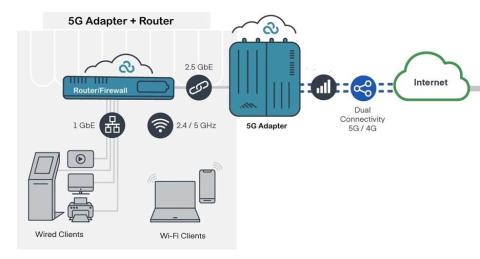Is 5G Wireless WAN Ready for Fixed Primary Access in Retail?
As 5G tech advances, retailers need to consider its potential benefits to cost and the customer experience.
Wired connection has long been the traditional method of providing internet connectivity to businesses and homes. However, we are quickly approaching major opportunities within wireless networking. Fixed wireless access, or FWA, refers to the use of broadband cellular networks (4G, LTE, 5G) as a primary connection instead of land-based cabling. As 5G solutions increasingly progress, ABI Research predicts 5G-based FWA connections will hit 72 million worldwide by 2027, representing 35% of the total FWA market (Meyer). While 4G has typically been used as a failsafe option in hybrid WAN environments, this was due to the technology’s poor broadband capabilities. With the rapid development of technology, utilizing 5G as a primary access link may provide increased operational benefits and cost benefits to enterprises.
Wireless or wired?
How do you determine if fixed wireless access or wired access is better suited for your business needs? As fixed wireless access technology develops in the form of 5G and onward, wired access infrastructure is also developing via fiber optics. What are the real differences between the two and how does it affect the network environment? Fixed wireless access, or FWA, produces a wireless broadband connection between two points via radio signals from 5G networks. Fiber optic technology, however, utilizes physical cables to connect homes and businesses which are built either above ground, e.g. telephone poles, or underground. Both require devices on the customer premises to be used as termination points, but wired access requires the device to be connected via additional infrastructure

Benefits
What are the benefits of each? Some benefits of FWA include ease of use and cost efficiency. 5G connectivity is a plug and play solution and is easy to set up, with no need for the physical installment of fiber infrastructure. This infrastructure is costly to build and requires an upfront investment. 5G creates new opportunities for FWA and primary access because of its capability to deliver higher speeds at lower latency, enabling applications that were previously not wireless friendly. Additionally, 5G contains an architecture called ‘Network Slicing’ that will provide advanced QoS to the customer for service tiers based on application. However, FWA is limited in upload and download performance based on the spectrum band deployed, and you will typically see greater peak performances and consistency by using a fiber network.
Which is better for your business?
Physical cabling is still the most typical form of primary access with 4G and LTE being used as a failsafe in hybrid SD-WAN solutions, but there are cases where FWA is proving to provide better utility. In rural locations across the US where investment in fiber and cabling has lacked, FWA provides a low cost solution that is quick in deployment. Henley Enterprises, the largest Valvoline Instant Oil Franchisee, has been migrating towards 5G solutions due to the limitations, congestion, and costs present with available broadband options. Robert Reeder, CIO, Valvoline Instant Oil Change franchise Henley Enterprises reported, “We’ve had great success utilizing cellular as our primary Internet connection in areas where high-speed wired broadband is scarce, and we’d like to increase our reach with 5G.”
For a scaling business, expanding to new locations does not require additional time and money spent on installing infrastructure. In industries like retail, FWA generates more value for enterprises especially in the cases where there are pop-up locations, mobile kiosks, and stores within stores. Access to a 5G network allows for a safe and secure connection separate from other nearby networks. FWA also becomes especially valuable with a high amount of IoT devices that can improve the customer experience by giving personalized recommendations and provide enterprises with data on the customer journey.
Use Cases
Acuative has recently achieved Cradlepoint’s 5G for Enterprise Branch Specialization, and we are partnering with Cradlepoint to deliver 5G and wireless WAN solutions to our clients. For indoor environments, the Cradlepoint W1850 Series 5G Wideband Adapter offers a throughput of 2 Gbps and 2.5 GbE via LAN Connectivity. The adapter has dual connectivity with simultaneous 5G (low and mid band) and LTE cellular connections, creating a highly adaptive and dependable WAN environment. For outdoor environments, the Cradlepoint W2005 Series 5G Wideband Adapter offers dual connectivity with low/mid-band 5G and LTE connections and is designed to withstand extreme temperatures, water, and high winds. We’ve found that the typical configuration that lends itself to 5G deployment leverages outdoor 5G adapters that connect seamlessly to the branch router/firewall at the site. The connection leverages Power over Ethernet (PoE) technology which enables very flexible installation by providing power and connectivity to remote devices like access points and IoT devices.
Acuative works closely with Cradlepoint and other service providers to create WAN solutions for businesses across the U.S. Major enterprises across the country trust Acuative to manage their networks and help achieve their digital transformation. With our expertise and breadth of partner relationships, we provide a fully managed, customized solution that suits your business needs, whether it’s wired or wireless. To find out more about 5G, visit: www.acuative.com/5g-connectivity.



